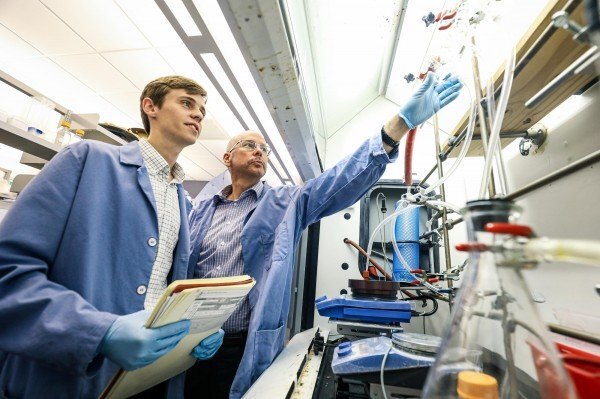Recent Furman University graduate Trent Stubbs is the author of a new study in Nature Chemistry that may fundamentally alter humanity’s understanding of the origin of life. The research was published today.
The study describes how organic chemical reactions could have started inorganically for the first time billions of years ago, according to a research discovery by former Furman University undergraduate Stubbs.
One of those elemental metabolic processes is called the Krebs cycle, also known as the citric acid cycle. The research by Stubbs and Furman Professor of Chemistry Greg Springsteen represents the first time the Krebs cycle has been replicated synthetically.
“Trent started with some small molecules and figured out how to make the Krebs cycle run, and it runs without enzymes in water at mild pH,” Springsteen said. “These discoveries have potential applications in understanding how life started on Earth, and where else in the universe it may emerge.”
To form their hypothesis, Stubbs and Springsteen started by asking what’s fundamental to life.
Find your dream job in the space industry. Check our Space Job Board »
“What’s in living cells?” Stubbs asked. “What are some of those core components that must have existed very early on? The answer is the citric acid cycle. This is one of the processes that turns food into energy. It doesn’t matter whether you’re human, plant, lizard, whatever … So it’s likely this cycle existed near the origins of life, and that’s what this paper is all about—how could simpler versions of this cycle, which now requires complex biological machinery to operate, have operated from the beginning without any of that evolved hardware?”
The paper also earned a place as the top story in Quanta Magazine as well as animated versions of Springsteen and Stubbs, first-year Ph.D. student at Emory University, appearing in the most recent Stated Clearly video, “What Is The Metabolism-First Hypothesis For The Origin Of Life?”
“Other scientists hailed the significance of the new findings, as well as the originality and rigorous chemical expertise of the researchers,” Quanta deputy editor John Rennie wrote.
The research behind the Nature Chemistry paper was the by-product of Springsteen’s role as a theme leader for a joint National Science Foundation (NSF) and NASA research consortium called the Center for Chemical Evolution. Springsteen specializes in applying the principles of mechanistic organic chemistry to understanding life and its origins, and he and his students have been working for more than a decade trying to unravel how natural chemical reactions could have evolved into a self-sustaining network of metabolic reactions, which is a central criterion for life.
Springsteen was named one of eight national Henry Dreyfus Teacher-Scholar Scholars in 2018, and federal grants he has written have brought in over $1 million in research and instrument funding to Furman over the last five years.
Stubbs’ discovery also led to novel ways to chemically synthesize biological diagnostic agents used in an emerging cancer and bacterial infection detection diagnostic method called metabolic flux analysis. Recognizing the commercial potential, Springsteen and Stubbs co-founded and launched Aconabolics LLC in July of 2018, which operates out of a specially constructed lab space on campus, to commercialize these results.
Springsteen and Stubbs are also the inventors on two patents that resulted from the research, which are the second and third in Furman’s history.
The Nature Chemistry publication is the culmination of three years’ work by Stubbs and Springsteen. They wrote the manuscript with substantial inputs from Mahipal Yadav and Ram Krishnamurthy of The Scripps Research Institute.
Provided by: Furman University
More information: R. Trent Stubbs et al. A plausible metal-free ancestral analogue of the Krebs cycle composed entirely of α-ketoacids. Nature Chemistry (2020). DOI: 10.1038/s41557-020-00560-7
Image: Trent Stubbs ’20 in lab with Furman Chemistry Professor Greg Springsteen.
Credit: Jeremy Fleming, Furman University











